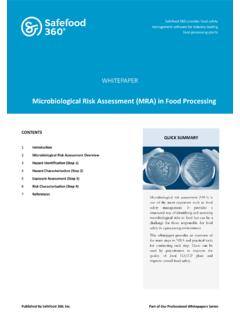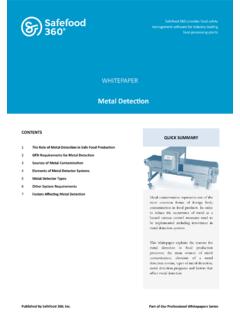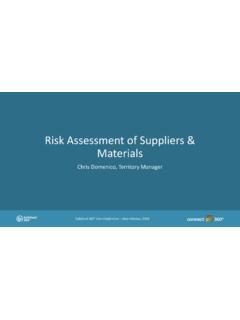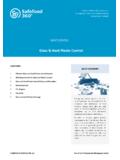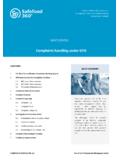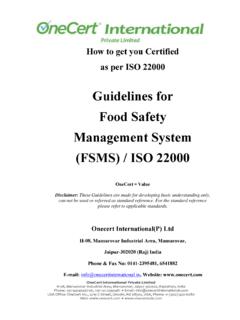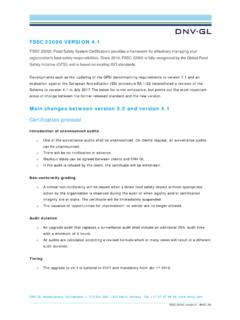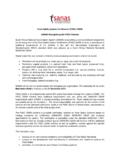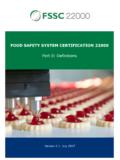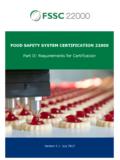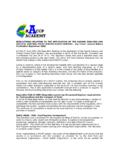Transcription of Managing Non-con ormance Categories - Safefood …
1 Managing Non-conformance CategoriesPage 1 Safefood 360, Inc. 2014 Part of Our Professional Whitepapers SeriesSUMMARYFood companies collect data on non-conformances within their operations but this valuable data is often lost in paper piles and poorly designed systems. In this whitepaper we will take a closer look at what exactly is a non-conformance, why we need to record them in the first place and how to design the systems that facilitate effective analysis and im-provement in your Introduction2. What is a non-conformance?3. How are non-conformances Identified?4. Why record non-conformances?5. Corrective and preventive action6.
2 Cause and effect analysis7. The true nature of non-conformances8. Developing a robust non-conformance structure9. Organising folders and Categories in Safefood 360 Safefood 360 is the provider of food safety management software for industry leading Non-conformance CategoriesManaging Non-conformance CategoriesPage 2 Safefood 360, Inc. 2014 Part of Our Professional Whitepapers Series1 IntroductionEvery day, food companies collect data on non-conformances within their oper-ations but this valuable information can often be lost in paper piles and poorly designed systems that have been devised for analysing the data.
3 In this whitepaper we will take a closer look at what exactly is a non-conformance, why we need to record them in the first place and how to design the systems that will facilitate ef-fective analysis and improvement in your business. Finally, we will provide tips on how to set up your non-conformance Categories in Safefood 360 .2 What is a non-conformance?The variation in how companies manage non-conformances in their food safety system is vast, and the design of these systems can either support or hinder the effectiveness of the continuous improvement policy. Good design and management of non-conformance data and specifically non-conformance cate-gories is crucial to making improvement a real part of the company s activities and not just a documented relates to a failure to comply with requirements.
4 A require-ment is a need, expectation, or obliga-tion. It can be stated or implied by an organization, its customers, or other interested are many types of requirements. Some of these include food safety re-quirements, quality requirements, pro-cess requirements, product requirements, customer requirements, management systems requirements, and legal require-ments. Whenever your organization fails to meet one of these requirements, a non-conformity occurs. For example, the ISO 22000 standard defines food safety management system requirements. When your organization deviates from these requirements, a non-conformance or nonconformity occurs.
5 Requirements by type include food safety, quality, process, product, material, supplier, systems and legal. 3 How are non-conformances identified?Within a typical food safety management system non-conformances are identified through a number of channels. These include customer complaints, internal audits, product recalls / withdrawals, external audits, regulatory notifications, incoming as well as in-process and final product inspection, testing and casual observation. A food business with a food safety management system certified to a specific standard will have in place a system for recording these Non-con -formances.
6 These standards will include the ISO 22000, GFSI and other industry standards. Managing Non-conformance CategoriesPage 3 Safefood 360, Inc. 2014 Part of Our Professional Whitepapers Series4 Why record non-conformances? There are two reasons why a food busi-ness will record non-conformances. Compliance Requirements to meet the specific requirements of a cus-tomer, standard or regulatory obligation. Process Improvement record-ing non-conformance data can facilitate analysis leading to incremental and con-tinuous improvement in business and operational processes. 5 Corrective and preventive actionLike most entities in a food safety man-agement system, a non-conformance does not exist in an insulated bubble.
7 It maintains a close relationship with cor-rective and preventive actions which of-ten occur together with the identification of non-conformances. For example, the ISO 22000 requires a business to have a non-conformance procedure in place with data capture as a prerequisite to tak-ing specific actions. It is this relationship between Non-con -formances and Corrective and Preven-tive Actions which will define the char-acter of the management system and some key processes. Figure 1 (below) illustrates the relation-ship between a non-conformance and we have already covered, a Non-con -formance is a failure to meet a require-ment.
8 When this occurs, the company should take action. There are two main types of action. Preventive action is an action taken to eliminate a potential non-conformance. Corrective action is an action taken to eliminate the cause of a non-conformance. We can see we have two main elements at play: Non-con -formance and actions. To fully under-stand these elements and their relation-ship we need to introduce the concepts of Cause and Cause and Effect AnalysisIn recent years, food safety standards have introduced the requirement of Root Cause Analysis (RCA). In times past, companies only needed to record Managing Non-conformance CategoriesPage 4 Safefood 360, Inc.
9 2014 Part of Our Professional Whitepapers Seriesthe non-conformance and then imple-ment corrective action. The requirement to explain the basis for the action was not specifically asked for and as a result actions were taken on an ad hoc basis with little concern for their effectiveness. The powers that be recognised that a more robust approach was needed. When a non-conformance is identified, in addition to recording the details, the company must examine all possible rea-sons that may have caused it. Only then can the company consider taking the appropriate actions. This approach has many benefits including finding timely and permanent solutions.
10 We can now develop our model a little further:Figure 2 (above) illustrates the relation-ship between non-conformance and actions with root cause and Effect Analysis is typically used to identify the root cause of the non-conformance. The technique em-ploys a structured brain storming and the use of diagrams to drive you towards the possible causes of the issue. Pio-neered by Professor Kaoru Ishikawa the approach is now widely used in manu-facturing as a quality management tool and is gaining increasing acceptability within the food sector. The tool is better known as the Fishbone using the tool, the first step is to clearly identify the problem or non-conformance the poor shelf life of a product.
